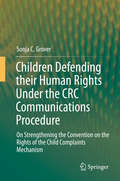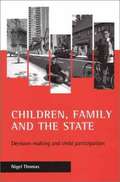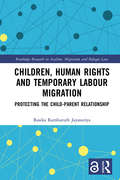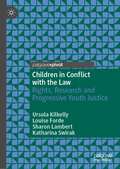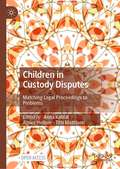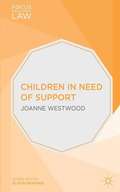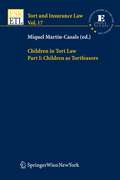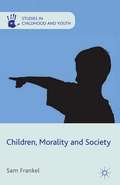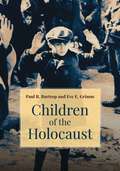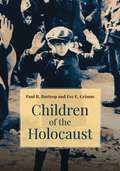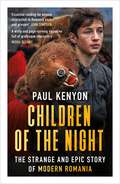- Table View
- List View
Children Defending their Human Rights Under the CRC Communications Procedure: On Strengthening the Convention on the Rights of the Child Complaints Mechanism
by Sonja C. GroverThis book considers the Optional Protocol to the Convention on the Rights of the Child on a communication procedure as a key contributor to the realization of children’s Article 12 Convention on the Rights of the Child participation rights. Weaknesses in the current formulation of the CRC communication procedure (its first iteration since entry into force 14 April, 2014) are examined and suggestions for strengthening of the mechanism in various respects considered. Actual cases concerning children’s fundamental human rights in various domains and brought under various international human rights mechanisms are considered as hypothetical OP3-CRC communications/complaints. In addition certain domestic cases brought to the highest State Court are considered as hypothetical OP3-CRC communications brought after exhaustion of domestic remedies. In this way various significant weaknesses of the OP3-CRC are illustrated in a compelling meaningful case context and needed amendments highlighted.
Children, Family and the State: Decision-Making and Child-Participation (PDF)
by Nigel ThomasWhat part should children take in decisions about their lives? Does their need to be involved in decisions conflict with adult responsibility for their welfare? In its search for answers to these questions, 'Children, family and the state' examines different theories of childhood, children's rights and the relationship between children, parents and the state. Focusing on children who are looked after by the state, it reviews the changing objectives of the care system and the extent to which children have been involved in decisions about their care.
Children, Human Rights and Temporary Labour Migration: Protecting the Child-Parent Relationship (Routledge Research in Asylum, Migration and Refugee Law)
by Rasika Ramburuth JayasuriyaThis book focuses on the neglected yet critical issue of how the global migration of millions of parents as low-waged migrant workers impacts the rights of their children under international human rights law. The work provides a systematic analysis and critique of how the restrictive features of policies governing temporary labour migration interfere with provisions of the Convention on the Rights of the Child that protect the child-parent relationship and parental role in children’s lives. Combining social and legal research, it identifies both potential harms to children’s well-being caused by prolonged child-parent separation and State duties to protect this relationship, which is deliberately disrupted by temporary labour migration policies. The book boldly argues that States benefitting from the labour of migrant workers share responsibility under international human rights law to mitigate harms to the children of these workers, including by supporting effective measures to maintain transnational child-parent relationships. It identifies measures to incorporate children’s best interests into temporary labour migration policies, offering ways to reduce interferences with children’s family rights. This book fills a gap that emerges at the intersection of child rights studies, migration research and existing literature on the purported nexus between labour migration and international development. It will be a valuable resource for academics, researchers and policymakers working in these areas.
Children, Human Rights and Temporary Labour Migration: Protecting the Child-Parent Relationship (Routledge Research in Asylum, Migration and Refugee Law)
by Rasika Ramburuth JayasuriyaThis book focuses on the neglected yet critical issue of how the global migration of millions of parents as low-waged migrant workers impacts the rights of their children under international human rights law. The work provides a systematic analysis and critique of how the restrictive features of policies governing temporary labour migration interfere with provisions of the Convention on the Rights of the Child that protect the child-parent relationship and parental role in children’s lives. Combining social and legal research, it identifies both potential harms to children’s well-being caused by prolonged child-parent separation and State duties to protect this relationship, which is deliberately disrupted by temporary labour migration policies. The book boldly argues that States benefitting from the labour of migrant workers share responsibility under international human rights law to mitigate harms to the children of these workers, including by supporting effective measures to maintain transnational child-parent relationships. It identifies measures to incorporate children’s best interests into temporary labour migration policies, offering ways to reduce interferences with children’s family rights. This book fills a gap that emerges at the intersection of child rights studies, migration research and existing literature on the purported nexus between labour migration and international development. It will be a valuable resource for academics, researchers and policymakers working in these areas.
Children in Conflict with the Law: Rights, Research and Progressive Youth Justice (Palgrave Critical Studies in Human Rights and Criminology)
by Ursula Kilkelly Louise Forde Sharon Lambert Katharina SwirakThis book presents an original synthesis of the leading international research on children in conflict with the law, providing an evidence base for a rights-based justice system. Informed by international children’s rights standards, this book presents relevant research findings in a clear, succinct and accessible manner, identifying the key evidence underpinning three rights-based themes of Prevention, Diversion and Justice, and Reintegration. This book is the first analysis to map leading inter-disciplinary research against the international children’s rights framework in relation to children and the justice system. In this way, it provides a unique evidence base for the implementation of children’s rights in youth justice and will support all those seeking to study, advocate or implement progressive approaches to children in conflict with the law.
Children in Custody: Anglo-Russian Perspectives
by Mary McAuleyDespite their very different histories, societies, political and legal systems, Russia and the UK stand out as favouring a punitive approach to young law breakers, imprisoning many more children than any other European countries. The book is based on the author's primary research in Russia in which she visited a dozen closed institutions from St Petersburg to Krasnoyarsk and on similar research in England and Northern Ireland.The result is a unique study of how attitudes to youth crime and criminal justice, the political environment and the relationship between state and society have interacted to influence the treatment of young offenders. McAuley's account of the twists and turns in policy towards youth illuminate the extraordinary history of Russia in the twentieth century and the making of social policy in Russia today.It is also the first study to compare the UK (excluding Scotland because of its separate juvenile justice system) with Russia, a comparison which highlights the factors responsible for the making of 'punitive' policy in the two societies. McAuley places the Russian and UK policies in a European context, aiming to reveal how other European countries manage to put so many fewer children behind bars.
Children in Custody Disputes: Matching Legal Proceedings to Problems
by Anna Kaldal Agnes Hellner Titti MattssonThis open access book explores how legal proceedings in and out-of-court can be matched to the complex problems underlying disputes concerning child custody, residence and contact between parents. It focusses in particular on Nordic experiences of in and out-of-court mechanisms as means of resolving custody disputes. The contributors are internationally renowned and experienced researchers from the legal, psychological, and sociological fields who provide empirical as well as legal perspectives. They examine central legal, ethical and knowledge-based dilemmas in custody dispute proceedings. The findings speak to an international audience and suggest ways how to best realize the interests of the child. It transcends disciplinary, institutional, and jurisdictional boundaries in search of new knowledge.
Children in Need of Support (Focus On Social Work Law Ser.)
by Joanne WestwoodIn order to ensure a safe and happy environment for children in need, it is essential that the support they receive is as effective and timely as possible. It is for this reason that the interventions and support provided by practitioners working in the field is heavily governed by legislation and guidance. Children in Need of Support provides students and practitioners with a clear and practical account of the key legislation and guidance. It begins by outlining the legal framework as it applies to working with children in need, along with the duties, powers and responsibilities of the practitioners supporting them. Linking the theory to practice scenarios, it considers the different assessment and support needs of specific groups of children, including: separated, unaccompanied and refugee children, children with harmful sexual behaviour and children with disabilities. The text is supported by a range of innovative features and boxed information to aid learning and stimulate reflection: - Key Case Analysis boxes summarize the details of particular legal cases and outline the implications for social work practice - Practice Focus boxes apply legal principles and processes to practice through the use of social work scenarios - On-The-Spot Questions reinforce understanding and encourage critical reflection
Children in Street Situations: A Concept in Search of an Object (Children’s Well-Being: Indicators and Research #21)
by Riccardo Lucchini Daniel StoecklinThis book provides new insights on the lives of children in street situations by providing analyses from a qualitative perspective on the sociology of childhood. It proposes some insightful perspectives on the current discussion about the rights of children in street situations. It includes a unique selection of texts, which were initially published in French, written by the authors of this volume, on the lives of children in street situations in Latin America and China, that are now available to an English readership. It challenges obstacles, linked to macrosocial issues such as inequalities, images of the child, the separation of public/private spheres, urban dynamics and structural adjustments, as well as to microsocial dimensions such as identity, motivation, and activities that are constitutive of street situations. The book discusses the situations experienced by children, highlighting children’s reflexivity and strategies as social factors, and shedding new light on the debate “agency within structure”.
Children in Tort Law, Part I: Children as Tortfeasors (Tort and Insurance Law #17)
by Miquel Martín-CasalsThis volume gives answers to different questions concerning damage caused by children. Are children directly liable and is there any age limit below which they have no tortious capacity? Can children, in spite of their lack of tortious capacity, for reasons of equity be held liable in exceptional conditions? What is the relationship between liability of children and liability of their parents or guardians? Are these questions answered by special rules of general application in all fields of tort liability or are there specific rules for specific torts? The book includes reports from 11 EU Member States and from Russia and a comparative analysis.
Children in Tort Law, Part II: Children as Victims (Tort and Insurance Law #18)
by Miquel Martín-CasalsSince children are not as capable as adults to perceive the risks involved in many situations of daily life, they are at a high risk of suffering personal injuries, mainly resulting from home, school and traffic accidents. From the tort law perspective, this requires a specific treatment of children as victims. For the last few decades some legal systems have been trying to find new solutions for a better protection of children, while other legal systems still follow more traditional rules. After having tackled the problems concerning the position of children as tortfeasors in a previous book, in this book the same working team deals with the problems related to the position of children as victims. This book analyses both the traditional solutions found in some legal systems and the newer solutions offered by others and devotes specific attention to damage issues, apportionment of damage and insurance problems when the victim is a child.
Children, Morality and Society (Studies in Childhood and Youth)
by S. FrankelThis book explores the extent to which children engage with questions of morality, arguing that they are active members of society who have both the capacity and understanding to engage with discourses of morality.
Children of the Holocaust
by Paul R. Bartrop Eve E. GrimmThis important reference work highlights a number of disparate themes relating to the experience of children during the Holocaust, showing their vulnerability and how some heroic people sought to save their lives amid the horrors perpetrated by the Nazi regime.This book is a comprehensive examination of the people, ideas, movements, and events related to the experience of children during the Holocaust. They range from children who kept diaries to adults who left memoirs to others who risked (and, sometimes, lost) their lives in trying to rescue Jewish children or spirit them away to safety in various countries. The book also provides examples of the nature of the challenges faced by children during the years before and during World War II. In many cases, it examines the very act of children's survival and how this was achieved despite enormous odds.In addition to more than 125 entries, this book features 10 illuminating primary source documents, ranging from personal accounts to Nazi statements regarding what the fate of Jewish children should be to statements from refugee leaders considering how to help Jewish children after World War II ended. These documents offer fascinating insights into the lives of students during the Holocaust and provide students and researchers with excellent source material for further research.
Children of the Holocaust
by Paul R. Bartrop Eve E. GrimmThis important reference work highlights a number of disparate themes relating to the experience of children during the Holocaust, showing their vulnerability and how some heroic people sought to save their lives amid the horrors perpetrated by the Nazi regime.This book is a comprehensive examination of the people, ideas, movements, and events related to the experience of children during the Holocaust. They range from children who kept diaries to adults who left memoirs to others who risked (and, sometimes, lost) their lives in trying to rescue Jewish children or spirit them away to safety in various countries. The book also provides examples of the nature of the challenges faced by children during the years before and during World War II. In many cases, it examines the very act of children's survival and how this was achieved despite enormous odds.In addition to more than 125 entries, this book features 10 illuminating primary source documents, ranging from personal accounts to Nazi statements regarding what the fate of Jewish children should be to statements from refugee leaders considering how to help Jewish children after World War II ended. These documents offer fascinating insights into the lives of students during the Holocaust and provide students and researchers with excellent source material for further research.
Children of the Night: The Strange and Epic Story of Modern Romania
by Paul KenyonA vivid, brilliant, darkly humorous and horrifying history of some of the strangest dictators that Europe has ever seen. 'A witty and page-turning narrative full of grotesque characters' Misha Glenny 'Will leave you astonished, exhausted and curious... An unapologetic page turner' Spectator 'Essential reading for anyone interested in Romania past and present' John Simpson 'An engaging introduction to the rich history [of Romania]' New StatesmanBalanced precariously on the shifting fault line between East and West, Romania's past is one of the great untold stories of modern Europe. The country that gave us Vlad Dracula, and whose citizens consider themselves descendants of ancient Rome, has traditionally preferred the status of enigmatic outsider. But it has experienced some of the most disastrous leaderships of the last century.After a relatively benign period led by a dutiful King and his vivacious British-born Queen, the country oscillated wildly. Its interwar rulers form a gallery of bizarre characters: the corrupt and mentally unbalanced King Carol; the fascist death cult led by Corneliu Codreanu; the vain General Ion Antonescu. After 1945 power was handed to Romania's tiny communist party, under which it experienced severe repression, purges and collectivisation. Then in 1965, Nicolae Ceau?escu came to power. And thus began the strangest dictatorship of all.
‘Children Out of Place’ and Human Rights: In Memory of Judith Ennew (Children’s Well-Being: Indicators and Research #15)
by Antonella Invernizzi Manfred Liebel Brian Milne Rebecca BuddeThis volume brings together tributes to Judith Ennew’s work and approach based on issues related to children she once referred to as ‘out of place’, that is to say children whose living conditions and ways of life appear far removed from Western images of childhood. It includes contributions on working children, children living on the street, orphans and victims of sexual exploitation. It covers developments and concepts used by Judith Ennew with an emphasis on perspectives of children’s human rights, their participation, cultural sensitivity, research methodology, methods, ethics, monitoring, policy making and programming. In so doing, it brings together material that form a holistic view of not only her way of thinking, but of a policy and programming agenda developed by a number of researchers, academics and activists since the adoption of the UN Convention on the Rights of the Child.
Children, Religion and the Ethics of Influence (Bloomsbury Philosophy of Education)
by John TillsonIn Children, Religion and the Ethics of Influence, John Tillson develops a theory concerning which kinds of formative influence are morally permissible, impermissible or obligatory. Applying this theory to the case of religion, he argues that religious initiation in childhood is morally impermissible whether conducted by parents, teachers or others. Tillson addresses questions such as: how we come to have the ethical responsibilities we do, how we understand religion, how ethical and religious commitments can be justified, and what makes children ethically special.
Children, Religion and the Ethics of Influence (Bloomsbury Philosophy of Education)
by John TillsonIn Children, Religion and the Ethics of Influence, John Tillson develops a theory concerning which kinds of formative influence are morally permissible, impermissible or obligatory. Applying this theory to the case of religion, he argues that religious initiation in childhood is morally impermissible whether conducted by parents, teachers or others. Tillson addresses questions such as: how we come to have the ethical responsibilities we do, how we understand religion, how ethical and religious commitments can be justified, and what makes children ethically special.
Children Taken Seriously: In Theory, Policy and Practice
by Toby Fattore Jan Mason Chris GoddardIn Children Taken Seriously, leading researchers and policy makers consider how children can be recognized as social actors rather than passive consumers or victims. Using children's own views and experiences as a starting point, they explore how children can be involved as partners in the decision-making processes that affect them, in social work, education, health care and broader social policies. Chapters on the theoretical background draw parallels between developments in children's and women's rights, and discuss communication issues and social and sexual constructions of children. Other chapters explore issues of policy and practice in a variety of areas, from Family Group Conferencing and child protection to child labour and notions of active citizenship. Highlighting the important role of schools in empowering children, the authors discuss children's engagement in and participation in their own education and how children's rights theory influences debates over discipline. This accessible and thought-provoking book is a rich source of insight and ideas for social workers, teachers, mental health professionals and anyone working with children.
Children Taken Seriously: In Theory, Policy and Practice (PDF)
by Chris Goddard Jan Mason Toby FattoreIn Children Taken Seriously, leading researchers and policy makers consider how children can be recognized as social actors rather than passive consumers or victims. Using children's own views and experiences as a starting point, they explore how children can be involved as partners in the decision-making processes that affect them, in social work, education, health care and broader social policies. Chapters on the theoretical background draw parallels between developments in children's and women's rights, and discuss communication issues and social and sexual constructions of children. Other chapters explore issues of policy and practice in a variety of areas, from Family Group Conferencing and child protection to child labour and notions of active citizenship. Highlighting the important role of schools in empowering children, the authors discuss children's engagement in and participation in their own education and how children's rights theory influences debates over discipline. This accessible and thought-provoking book is a rich source of insight and ideas for social workers, teachers, mental health professionals and anyone working with children.
Children & the Law: Shaping the Modern Welfare Principle in the British Isles (Children and the Law)
by Kerry O'HalloranBalancing a child’s welfare interests and rights so as to ensure recognition and respect for his or her autonomous identity, while facilitating family unity, has become a major challenge for modern family law. This book, following on from The Principle of the Welfare of the Child: A History, examines, contrasts and compares the response of England & Wales and Ireland to that challenge. It does so by applying the same matrix of indicators to explore, in each country, the distinction between welfare interests and rights and to trace changes in the balance between them. By profiling the nations in accordance with the same indicators it reveals important jurisdictional differences in the extent to which welfare interests or rights determine how the law is currently applied to children.
Children & the Law: Shaping the Modern Welfare Principle in the British Isles (Children and the Law)
by Kerry O'HalloranBalancing a child’s welfare interests and rights so as to ensure recognition and respect for his or her autonomous identity, while facilitating family unity, has become a major challenge for modern family law. This book, following on from The Principle of the Welfare of the Child: A History, examines, contrasts and compares the response of England & Wales and Ireland to that challenge. It does so by applying the same matrix of indicators to explore, in each country, the distinction between welfare interests and rights and to trace changes in the balance between them. By profiling the nations in accordance with the same indicators it reveals important jurisdictional differences in the extent to which welfare interests or rights determine how the law is currently applied to children.
Children, the Law and the Welfare Principle: Perspectives from North America (Children and the Law)
by Kerry O'HalloranThis book continues the themes addressed by its two predecessors in this mini-series by examining the role of the principle of the welfare interests of the child in the law of the U.S. and Canada. It provides a record of the key milestones in its development in each country and conducts a comparative analysis of the contemporary law relating to children in both. In doing so, it focuses also on the Indigenous communities – the AN/AI and the First Nations – of the U.S. and Canada respectively. By identifying and analysing the functions of the principle in the public (care, protection and control, etc), private (matrimonial, adoption, etc) and hybrid (adoption from care, surrogacy, etc) sectors of family law, it builds a picture of the law relating to children in the two countries and reveals significant jurisdictional differences. By examining the legislation and related caselaw, it assesses the different effects of the same legal framework on the welfare of Indigenous and other children. In addition to a digest of cases and legislation that identifies and tracks the role of this legal principle, lawyers, academics and other researchers will find a wealth of information on how it has evolved to reflect corresponding changes in social mores. For those interested in politics and social policy, there is much illuminating evidence of how the law has balanced this principle relative to others in both civil and criminal contexts.
Children, the Law and the Welfare Principle: Perspectives from North America (Children and the Law)
by Kerry O'HalloranThis book continues the themes addressed by its two predecessors in this mini-series by examining the role of the principle of the welfare interests of the child in the law of the U.S. and Canada. It provides a record of the key milestones in its development in each country and conducts a comparative analysis of the contemporary law relating to children in both. In doing so, it focuses also on the Indigenous communities – the AN/AI and the First Nations – of the U.S. and Canada respectively. By identifying and analysing the functions of the principle in the public (care, protection and control, etc), private (matrimonial, adoption, etc) and hybrid (adoption from care, surrogacy, etc) sectors of family law, it builds a picture of the law relating to children in the two countries and reveals significant jurisdictional differences. By examining the legislation and related caselaw, it assesses the different effects of the same legal framework on the welfare of Indigenous and other children. In addition to a digest of cases and legislation that identifies and tracks the role of this legal principle, lawyers, academics and other researchers will find a wealth of information on how it has evolved to reflect corresponding changes in social mores. For those interested in politics and social policy, there is much illuminating evidence of how the law has balanced this principle relative to others in both civil and criminal contexts.
Children, the Law and the Welfare Principle: Perspectives from Australia & New Zealand (Children and the Law)
by Kerry O'HalloranThis book contrasts and compares the different application of the law relating to the welfare interests of children in Australia and New Zealand including, respectively, the Indigenous and Māori children of those countries. It does so by applying the same matrix of indicators to explore jurisdictional differences between welfare interests and rights in the contexts of public family law (civil – care and protection etc and criminal – youth justice etc); private family law (matrimonial, adoption etc); and hybrid public/private family law (wardship, adoption from state care etc). By profiling the nations in accordance with the same indicators it reveals important jurisdictional differences in the extent to which welfare interests or rights determine how the law is currently applied to children in Australia and New Zealand.
